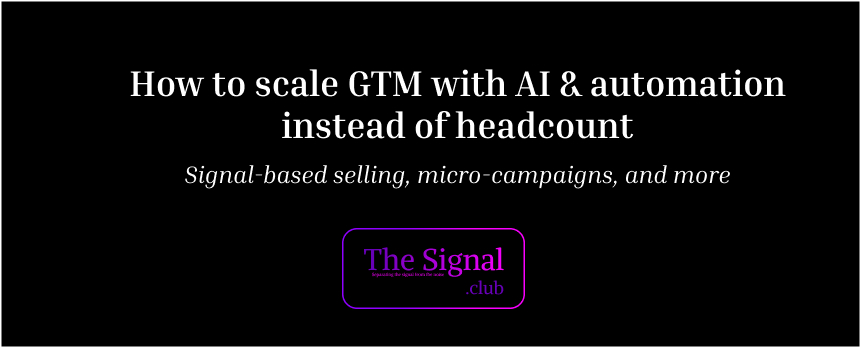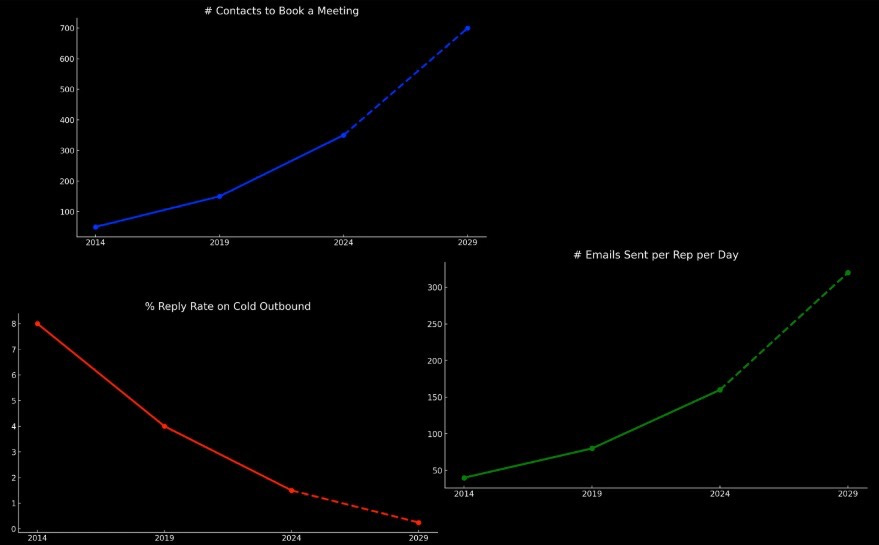How to Scale GTM with AI & Automation, Instead of Headcount
The Signal
If you were forwarded this newsletter, join 3,050 weekly readers—some of the smartest GTM founders and operators—by subscribing here:
Hey, y’all!
In the last month, around 1,000 new folks have joined this weird little corner of the internet we’ve created - where we nerd out on the future go-to-market playbook, and the infrastructure that will run it (yes, AI included).
So, for those who are new around these parts - a quick reminder that this newsletter is 100% organic, hand-rolled (not written by AI), and it’ll be free forever.
My aim is: to share the new GTM motions that I’m creating and/or (mostly) curating. The “alpha,” if you will.
Today’s post is my best effort at summarizing my exploration into how the best GTM teams in the world are building pipeline by being creative and thoughtful. (No spam cannon required). These methods and tools help us answer one simple question:
Which companies/people are most likely to have a sales conversation with us this week?
Less volume = more efficiency in the B2B software marketplace (better for both buyers and sellers).
And, I love me some efficiencies in the world. (Ask my wife, who still shakes her head every time I try and convince her we should show up at their airport as close to our departure time as possible, as to not waste any time waiting around by our gate with the other sheep.)
Here’s what we cover in today’s post:
The old playbook is broken
Why the old playbook broke
A new playbook is emerging
Three phases of modern selling
Phase 1: Sequence-era
Phase 2: Signal-based selling-era
Phase 3: AI-era
Who runs this new playbook?
Alright, let’s get into it.
[I can’t stop listening to the poppy benson bronson after his Grammy’s performance (based Zuck may have gone too far imitating benson). Feel free to listen to this track while you’re reading this week’s post.]
I have talked with several founders and GTM execs lately who have a goal of scaling their go-to-market motion, without hiring a bunch more headcount. Instead, they’re looking to identify opportunities throughout their business to inject automation and AI, to get more done with their existing team. One founder told me: “We’re not hiring like we did last year; but, our number is going up significantly.” It’s a big bet on using technology to help the existing sellers become more efficient. ARR per rep is becoming ‘cool’ again. (RIP ZIRP-era)
The old playbook is broken
Hiring a bunch of SDRs, buying a B2B database, building lists, and adding prospects into basic persona-based sequences doesn’t work anymore like it used to.
I wrote about this topic in a couple of posts:
Here’s the TLDR:
2011: Aaron Ross wrote the book on outbound: Predictable Revenue. That’s when the SDR Playbook was first popularized.
2015: Outreach and SalesLoft raised their Series A’s. This started the boom of cold, outbound email, at scale.
2024: Today, Smartlead and Instantly are leading the charge on tooling to enable outbound email at scale; they have $10s of millions in revenue. Both founded in the last three (!!) years. And companies like 11x.ai and Artisan are actively raising piles of cash for their AI SDRs. (Note: these aren’t all spam cannons)
So, here we are.
Sending insane amounts of email to generate pipeline in a world that is already overwhelmed with messages across all platforms (not just email).
I put together some charts to illustrate the trendlines across a few metrics:
Why the old playbook broke
It’s worth calling out why the old playbook is broken. Because, I don’t think these reasons get better in the coming years. In fact, I’m fairly confident they’ll become even stronger headwinds for pipe gen. As far as I can tell, here are the top reasons why the playbook doesn’t work like it used to:
1/ ZIRP-era is behind us
The cost of capital was nearly zero during the VC vintages of ~2020-2023. It was ‘the boom times.’ That meant, hiring went bananas.
2/ More competitors
AI has made it so that anyone can build just about anything for nearly zero dollars. Seriously, you can spend $20 and have Sonnet 3.7 or Replit or v0 generate an incredibly sufficient web application. And remember, this is the worst these tools will ever be.
This new reality simply means: there are—and will continue to be—more competitors, in every category.
3/ More distractions
It’s almost impossible to go five minutes without getting a ping (email, slack, text, DM, notifications on computer or phone, etc.). We’re bombarded with distractions 24/7.
So, if you’re a seller trying to get in front of buyers, it’s never been harder to break through the noise.
4/ Known playbook
Predictable Revenue was published in 2011. Then blogs and LinkedIn posts continued to share out best-practices. I think this is an amazing world to live in (where information is abundant and free!). But, it does mean that what used to be alpha, is now tablestakes. The new alpha is in using AI and automation in clever ways that other teams aren’t doing (yet).
So, there you have it. We have a broken playbook, and the reasons why are only going to make it less effective over time.
So, what do we do about it?
Well, I’m glad you asked…
A new playbook is emerging
Last week, a founder friend, Amos, put up a LinkedIn post talking about this new era of company-building.
He opens the post saying: Bolt and Lovable just went from zero to $15M ARR in 2 months with 15 employees. Media calls them "AI miracles". Yet everyone missed the real story: We're witnessing the first wave of autonomous businesses in history.
He goes on to say, “These companies aren't winning because of their AI. They're winning because they've cracked a completely new operating system for building companies.”
And here’s the spoiler:
It's not about replacing humans with AI agents.
It's about turning your existing talent into superhumans - empowering a small team to operate at enterprise scale.These companies didn't automate their humans away.
They fundamentally reimagined how humans and AI work together.
Sounds like what the smartest GTM teams are doing right now.
This is the moment in history where we see the 10X rep, or even the 100X rep! (…no, seriously) become a reality.
I think this playbook is being written as we speak.
And in 2035, we’ll look back and say “man, all you had to do was show up in the arena, and you would win.”
Three phases of modern selling
This is a simple concept I’ve been thinking through lately:
→ Phase 1: Sequence-era [2015-2022]
→ Phase 2: Signal-based selling era [2022-?]
→ Phase 3: AI era [2025-???]
I think we’re in a moment where signal-based selling is a great way to build a go-to-market motion. But, I also believe that signals will become commoditized by all of the platforms building tooling to make operationalizing them easier/better/faster/cheaper. Platforms like Apollo, Common Room, Koala, Pocus, Rox, Unify, UserGems, Zoominfo, et. al. In a year or two, anyone will be able to click a button and a “Website visitor Play” will get spun up. Or a “Champion Tracking Play.” Or a “Closed-lost Resurrect Play.” And so on. This is great news for the marketplace - both buyers and sellers! Identifying your “signal-based market” means fewer activities, but higher conversions against them:
But, what’s emerging in ‘Phase 3’, the AI era, is super compelling to me. And, I think it’s durable. Because there is no ‘one-size-fits-all’ with AI playbooks. It comes down to who knows their customers the best. And who can come up with creative, thoughtful experiments, that leverage AI and automation, to do far less volume, but that converts at much higher rates.
Who runs this new playbook?
I don’t want to open too big of a can of worms here. But… I do have to say - I think the teams running this new playbook will change. How you staff a modern GTM org is going to look very different in 2026, than it did in 2021.

Here are a few thoughts, in no particular order:
RevOps continues to be a strategic role across all GTM departments
The role of the SDR will continue to evolve, but remain highly relevant
There is a new way of buying—optionality!
Founder brand is still an early concept (going direct to your audience)
GTM Engineers will run signal-based selling and micro-campaigns at scale
•••
I feel lucky to be witnessing this shift in real-time. Things seem chaotic, and most days I can barely keep up. I guess this is what it feels like to be ripping up the first half of an S-curve. Hold on for dear life, because I think we have some more room to go before we start to level off.
As always, thank you for your continued attention and trust—I do not take it for granted.
See you next week,
Brendan 🫡








I was a bit misled by this headline -- and expected some general framework around how AI and automation would help scale GTM motions. Based on my read, it sounds like creating playbooks based on a deep understanding of customers and using AI to support segment specific 'plays' based on signals (another way of saying scoring, IMHO) is the thrust. Isn't that more of the same with new toys? I'm not trying to troll, I'm just trying to find the delta between the new strategic approach that will come with automation and past attempts. Can you clarify?
Love this approach.
I wrote a little about the Vibe Sales movement here, very similar themes
https://www.linkedin.com/pulse/vibe-sales-manifesto-zachary-king-bypuc?utm_source=share&utm_medium=member_ios&utm_campaign=share_via